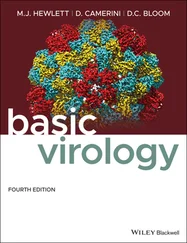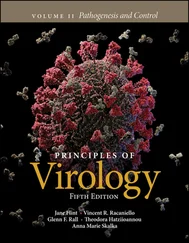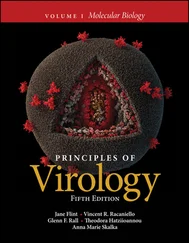Jane Flint - Principles of Virology
Здесь есть возможность читать онлайн «Jane Flint - Principles of Virology» — ознакомительный отрывок электронной книги совершенно бесплатно, а после прочтения отрывка купить полную версию. В некоторых случаях можно слушать аудио, скачать через торрент в формате fb2 и присутствует краткое содержание. Жанр: unrecognised, на английском языке. Описание произведения, (предисловие) а так же отзывы посетителей доступны на портале библиотеки ЛибКат.
- Название:Principles of Virology
- Автор:
- Жанр:
- Год:неизвестен
- ISBN:нет данных
- Рейтинг книги:3 / 5. Голосов: 1
-
Избранное:Добавить в избранное
- Отзывы:
-
Ваша оценка:
- 60
- 1
- 2
- 3
- 4
- 5
Principles of Virology: краткое содержание, описание и аннотация
Предлагаем к чтению аннотацию, описание, краткое содержание или предисловие (зависит от того, что написал сам автор книги «Principles of Virology»). Если вы не нашли необходимую информацию о книге — напишите в комментариях, мы постараемся отыскать её.
Volume I: Molecular Biology
Volume II: Pathogenesis and Control
Principles of Virology, Fifth Edition
Principles of Virology — читать онлайн ознакомительный отрывок
Ниже представлен текст книги, разбитый по страницам. Система сохранения места последней прочитанной страницы, позволяет с удобством читать онлайн бесплатно книгу «Principles of Virology», без необходимости каждый раз заново искать на чём Вы остановились. Поставьте закладку, и сможете в любой момент перейти на страницу, на которой закончили чтение.
Интервал:
Закладка:
Table of Contents
1 Cover
2 Volume I
Preface Preface The enduring goal of scientific endeavor, as of all human enterprise, I imagine, is to achieve an intelligible view of the universe. One of the great discoveries of modern science is that its goal cannot be achieved piecemeal, certainly not by the accumulation of facts. To understand a phenomenon is to understand a category of phenomena or it is nothing. Understanding is reached through creative acts. A. D. HERSHEY Carnegie Institution Yearbook 65 All five editions of this textbook have been written according to the authors’ philosophy that the best approach to teaching introductory virology is by emphasizing shared principles. Studying the common steps of the viral reproductive cycle, illustrated with a set of representative viruses, and considering mechanisms by which these viruses can cause disease provides an integrated overview of the biology of these infectious agents. Such knowledge cannot be acquired by learning a collection of facts about individual viruses. Consequently, the major goal of this book is to define and illustrate the basic principles of virus biology. In this information-rich age, the quantity of data describing any given virus can be overwhelming, if not indigestible, for student and expert alike. The urge to write more and more about less and less is the curse of reductionist science and the bane of those who write textbooks meant to be used by students. In the fifth edition, we continue to distill information with the intent of extracting essential principles, while providing descriptions of how the information was acquired and tools to encourage our readers’ exploration of the primary literature. Boxes are used to emphasize major principles and to provide supplementary material of relevance, from explanations of terminology to descriptions of trailblazing experiments. Our goal is to illuminate process and strategy as opposed to listing facts and figures. In an effort to make the book readable, we have been selective in our choice of viruses that are used as examples. The encyclopedic Fields’ Virology [Knipe DM, Howley PM (ed). 2020. Fields Virology , 7th ed. Lippincott Williams & Wilkins, Philadelphia, PA] is recommended as a resource for detailed reviews of specific virus families.
What’s New What’s New This edition is marked by a welcome addition to the author team. Our new member, Theodora Hatziioannou, brings expertise in retrovirology, entry, and intrinsic immunity, as well as authority regarding ancient Greek mythology and philosophy that the attentive reader will see is generously sprinkled throughout the text. We have added an important new chapter in Volume II, “Therapeutic Viruses.” While the majority of the chapters define how viruses reproduce and cause mayhem to both cell and host, this new chapter turns the tables to discuss how viruses can be beneficial to eliminate tumor cells, deliver therapeutic genes to specific cells, and expand our arsenal of vaccines for prevention of virus-mediated diseases. The authors continually strive to make this text accessible and relevant to our readers, many of whom are undergraduates, graduate students, and postdoctoral fellows. Consequently, for this edition, we enlisted the aid of more than twenty of these trainees to provide guidance and commentary on our chapters and ensure that concepts are clearly explained and that the text is compelling to read. This unique group of editors has been invaluable in the design of all of our fully reworked and up-to-date chapters and appendices, and we extend a particular thank-you to them for sharing their perspectives. A new feature is the inclusion of a set of study questions and/or, in some cases, puzzles, as aids to ensure that the key principles are evident within each chapter. This section complements the Principles that begin each chapter, focusing on unifying core concepts. Finally, although the SARS-CoV-2 pandemic began as we were preparing to go to press, we have included additions to relevant chapters on the epidemiology, emergence, and replication of this global scourge, as well as some hopeful information concerning vaccine development. What is apparent is that, now more than ever, an appreciation of how viruses impact their hosts is not just an academic pursuit, but rather literally a matter of life and death. We extend our gratitude to all those who serve in patient care settings.
Principles Taught in Two Distinct, but Integrated Volumes Principles Taught in Two Distinct, but Integrated Volumes Volume I covers the molecular biology of viral reproduction, and Volume II focuses on viral pathogenesis, control of virus infections, and virus evolution. The organization into two volumes follows a natural break in pedagogy and provides considerable flexibility and utility for students and teachers alike. The two volumes differ in content but are integrated in style and presentation. In addition to updating the chapters and appendices for both volumes, we have organized the material more efficiently, and as noted above, added a new chapter that we believe reflects an exciting direction for the field. Links to Internet resources such as websites, podcasts, blog posts, and movies are provided within each chapter; the digital edition provides one-click access to these materials. As in our previous editions, we have tested ideas for inclusion in the text in our own classes. We have also received constructive comments and suggestions from other virology instructors and their students. Feedback from our readers was particularly useful in finding typographical errors, clarifying confusing or complicated illustrations, and pointing out inconsistencies in content. For purposes of readability, references are not included within the text; each chapter ends with an updated list of relevant books, review articles, and selected research papers for readers who wish to pursue specific topics. New to this edition are short descriptions of the key messages from each of the cited papers of special interest. Finally, each volume has a general glossary of essential terms. These two volumes outline and illustrate the strategies by which all viruses reproduce, how infections spread within a host, and how they are maintained in populations. We have focused primarily on animal viruses, but have drawn insights from studies of viruses that reproduce in plants, bacteria, and archaea.
Acknowledgments About the Authors Key of Repetitive Elements PART I: The Science of Virology 1 Foundations Luria’s Credo Viruses Defined Why We Study Viruses Virus Prehistory Discovery of Viruses The Defining Properties of Viruses Cataloging Animal Viruses A Common Strategy for Viral Propagation Perspectives References 2 The Infectious Cycle Introduction The Infectious Cycle Viral Pathogenesis Overcoming Host Defenses Cultivation of Viruses Assay of Viruses Viral Reproduction: the Burst Concept The One-Step Growth Cycle Global Analysis Single-Cell Virology Perspectives References PART II: Molecular Biology 3 Genomes and Genetics Introduction Genome Principles and the Baltimore System Structure and Complexity of Viral Genomes What Do Viral Genomes Look Like? Coding Strategies What Can Viral Sequences Tell Us? The “Big and Small” of Viral Genomes: Does Size Matter? The Origin of Viral Genomes Genetic Analysis of Viruses Perspectives References 4 Structure Introduction Building a Protective Coat Packaging the Nucleic Acid Genome Viruses with Envelopes Large Viruses with Multiple Structural Elements Other Components of Virions Mechanical Properties of Virus Particles Perspectives References 5 Attachment and Entry Introduction Attachment of Virus Particles to Cells Entry into Cells Intracellular Trafficking and Uncoating Import of Viral Genomes into the Nucleus Perspectives References 6 Synthesis of
Интервал:
Закладка:
Похожие книги на «Principles of Virology»
Представляем Вашему вниманию похожие книги на «Principles of Virology» списком для выбора. Мы отобрали схожую по названию и смыслу литературу в надежде предоставить читателям больше вариантов отыскать новые, интересные, ещё непрочитанные произведения.
Обсуждение, отзывы о книге «Principles of Virology» и просто собственные мнения читателей. Оставьте ваши комментарии, напишите, что Вы думаете о произведении, его смысле или главных героях. Укажите что конкретно понравилось, а что нет, и почему Вы так считаете.











